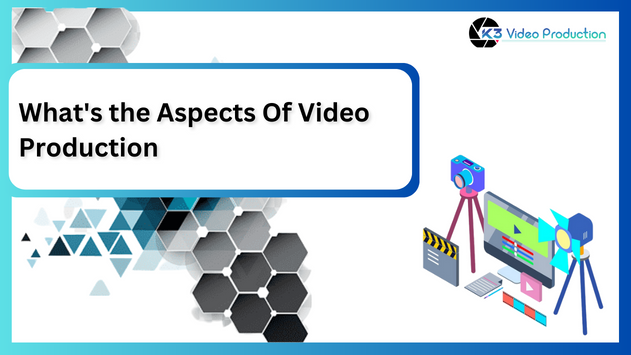What’s the Aspects of Video Production?
Table of Contents
ToggleA video production process involves many elements that come together to create captivating and impactful visual content. Each aspect of the production process plays a crucial role in shaping the final video. Any person interested in producing high-quality videos for various purposes, such as marketing, entertainment, education, or storytelling, should understand the key aspects of video production.
Pre-production tasks include conceptualizing ideas, scriptwriting, storyboarding, location scouting, casting, and assembling a production team. Before filming begins, all necessary elements are put in place to ensure a successful video shoot. Video production involves setting up cameras, capturing footage, directing talent, managing audio, and overseeing lighting and set design. The shots and performances at this stage require efficiency and attention to detail.
Post-production involves editing footage, adding visual effects, sound design, music, color grading, and finalizing the video. A polished and cohesive visual piece is created during this phase. These aspects of video production provide a solid foundation for creating videos that effectively communicate messages, engage audiences, and meet objectives. Beginners and aspiring filmmakers alike will benefit from grasping these fundamentals for successful video production.
What Is Video Production?
Video production involves creating and capturing moving visual content using cameras, lighting, sound equipment, and various production techniques. A final video product is crafted through a series of stages, including pre-production, production, and post-production. A variety of projects can be produced with video, including films, documentaries, advertisements, corporate videos, music videos, and more.
Concepts are conceptualized, scripts are written, locations are scouted, and the necessary resources are gathered during pre-production. Production consists of shooting the shots, actors performing their roles, and the production team ensuring everything goes smoothly. Final touches are added to a polished video during post-production, including editing, sound mixing, visual effects, and color grading.
Video production Chicago requires technical expertise, creativity, and collaboration among the production team. Due to technological advancements, producing professional-looking videos for various uses has become more accessible.
Aspects Of Video Production
The 10 essential aspects contributing to video production’s success will be discussed from pre- to post-production.
Pre-Production:
A successful video production starts with the pre-production phase. All aspects of a project need to be conceptualized, scripted, and planned. As part of this phase, you define the target audience, determine the purpose of the video, create a script or storyboard, select locations, cast actors, and organize the production team. Pre-production planning helps ensure the production process runs smoothly and avoids unnecessary delays.
Production Design:
Designing a video’s production includes visual elements that contribute to its overall feel and look. This involves enhancing the narrative and conveying the desired message through props, costumes, sets, and locations. The production design team creates a cohesive visual style in conjunction with the director. A visually engaging and immersive experience for the audience depends on attention to detail in production design.
Cinematography:
Cinematography is the art of capturing moving images. The camera operation, framing, composition, lighting, and camera movement are all part of the process. Using the appropriate camera angles, lenses, and lighting techniques, the cinematographer conveys the desired emotions and atmosphere. Video storytelling is enhanced by a skilled cinematographer who can transform a simple scene into an exquisite work of art.
Sound Design:
Video production Chicago relies heavily on sound design to enhance the audiovisual experience. The process involves capturing high-quality audio during filming and adding supplementary sounds afterward. Ambient noise, music, sound effects, and dialogue all contribute to sound design. A well-crafted sound design ensures clear dialogue, creates the desired mood, and immerses the audience in the story. A meticulous editing of the audio elements after filming is as important as the audio quality captured during filming.
Directing:
Video production is guided by the director’s vision. The production team, actors, and crew work closely together to ensure the creative objectives are met. The director guides the performances, maintains the visual style, and makes critical decisions regarding the overall storyline. Keeping a cohesive vision throughout the production requires effective communication and leadership skills from the director.
Camera Operation:
The camera operator is responsible for capturing the desired shots and angles as directed by the cinematographer and director. Their duties include operating the camera, adjusting the focus, and ensuring smooth camera movements. Visually appealing and dynamic shots enhance storytelling when captured using skilled camera operation. An operator must have a deep understanding of camera equipment, technical settings, and shot composition to deliver high-quality footage.
Editing:
Video editing is the process of transforming raw footage into a cohesive and engaging piece. A video editor selects the best shots, arranges them logically, and adds transitions, effects, and graphics. Also, they synchronize the audio and video tracks, adjust the pacing, and remove unwanted elements. Video editors play a critical role in ensuring that the final product flows smoothly and communicates its message effectively.
Post-Production:
The term ‘post-production’ refers to all the tasks that follow filming. It involves editing, color grading, visual effects, audio mixing, and video finalizing. Visual and auditory elements of the video can be fine-tuned during this phase. The video is enhanced and prepared for distribution across various platforms by skilled post-production professionals using various software tools and techniques.
Distribution:
The distribution of a video involves choosing the platforms and channels through which it will reach its intended audience. A distribution channel could be television, cinema, social media, a website, or another. A video’s reach and impact are maximized by understanding its target audience and selecting the right distribution channels. As part of this process, the video is also optimized for specific platforms, considering aspects such as aspect ratio, resolution, and file format.
Marketing and Promotion:
Marketing and promotion can make even the best-produced videos unnoticeable. Videos need marketing and promotion strategies to generate awareness, increase visibility, and attract the target audience. Optimizing search engine optimization (SEO) for online platforms, writing engaging descriptions, and using social media and other marketing channels are all included in this aspect.
Conclusion:
Video production requires a comprehensive understanding and effective implementation of the ten key aspects discussed above. Creating visually appealing, emotionally engaging, and impactful videos starts with pre-production planning and ends with distribution and promotion. The Video production Chicago team should focus on these aspects and ensure collaboration among each other so that compelling content can be produced that resonates with the target audience and achieves the company’s goals.








